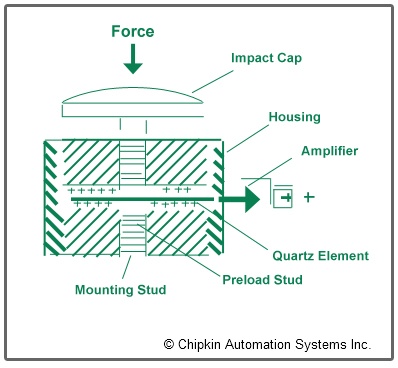Piezoelectric Force Sensor
A piezoelectric sensor is a device that employs the piezoelectric effect for the measurement of pressure, acceleration, strain or force by transforming them to an electrical signal. It is the most common dynamic force and acceleration detector. It is appropriately named after the Greek word piezo (which means "to squeeze") because a piezoelectric sensor generates a voltage when it is "squeezed" by a force that is proportional to the force applied.
Working Principle
An amplifier is used to convert the high impedance electrical signal (produced by the piezoelectric) to a low impedance signal. This makes it apt for use with an instrument like a digital storage oscilloscope. Digital storage of the signal is obligatory in order to enable analysis of the signal before it decomposes. Cross-sectional view of a typical piezoelectric force sensor is shown in the figure below:
Discharge Time Constant (DTC)
It is defined as the time needed for a sensor or measuring system to discharge its signal to 37% of the original value from a step change of measurand. This is accurate in case of every piezoelectric sensor, whether the operation is force, pressure or vibration monitoring. The DTC of a system is directly linked to the low frequency monitoring capabilities of a system. In the case of force monitoring, it becomes extremely significant as it is frequently desired to carry out quasi-static measurements.
Main Features
Fast response, ruggedness, stiffness comparable to solid steel, extended ranges and the ability to measure quasi-static forces are standard features coupled with piezoelectric force sensors. Following are the key features of piezoelectric force sensors:
- A piezoelectric force sensor is approximately as rigid as a comparably proportioned piece of solid steel. This stiffness and strength enables these sensors to be directly inserted into machines as part of their structure.
- Their rigidity bestows them with a high natural frequency, and their equivalent rapid rise time makes them ideal for measuring such rapid transient forces as those generated by metal-to-metal impacts and by high frequency vibrations.
- To make certain accurate measurement, the natural frequency of the sensing device must be considerably higher than the frequency to be measured. If the measured frequency comes close to the natural frequency of the sensor, measurement errors will result.
Applications
Based upon the application needs, dynamic force can be measured as either
- Compression,
- Tensile, or
- Torque force
Applications may incorporate
- The measurement of spring or sliding friction forces,
- Chain tensions,
- Clutch release forces,
- Peel strengths of laminates, labels, and pull tabs
Limitation
The basic point of distinction between piezoelectric devices and static force detection devices such as strain gauge is that the electrical signal generated by the crystal decays quickly after the application of force. This disparity renders these devices inappropriate for the detection of static force.
Sources
Comments (0)
